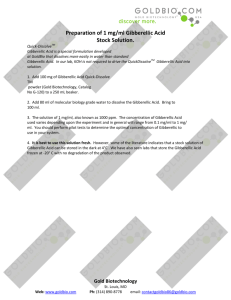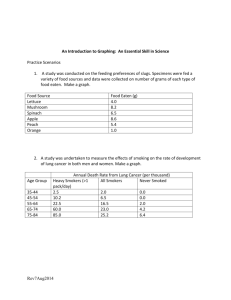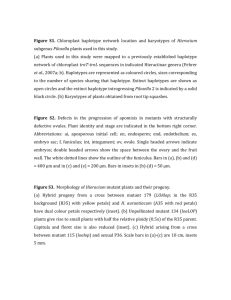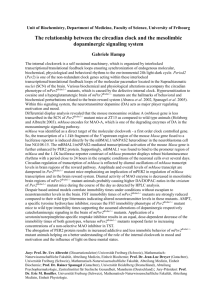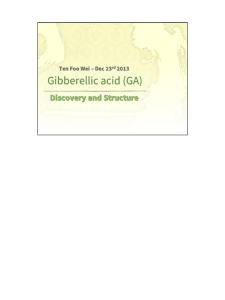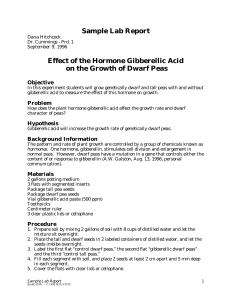LAB SHEET TEMPLATE
advertisement
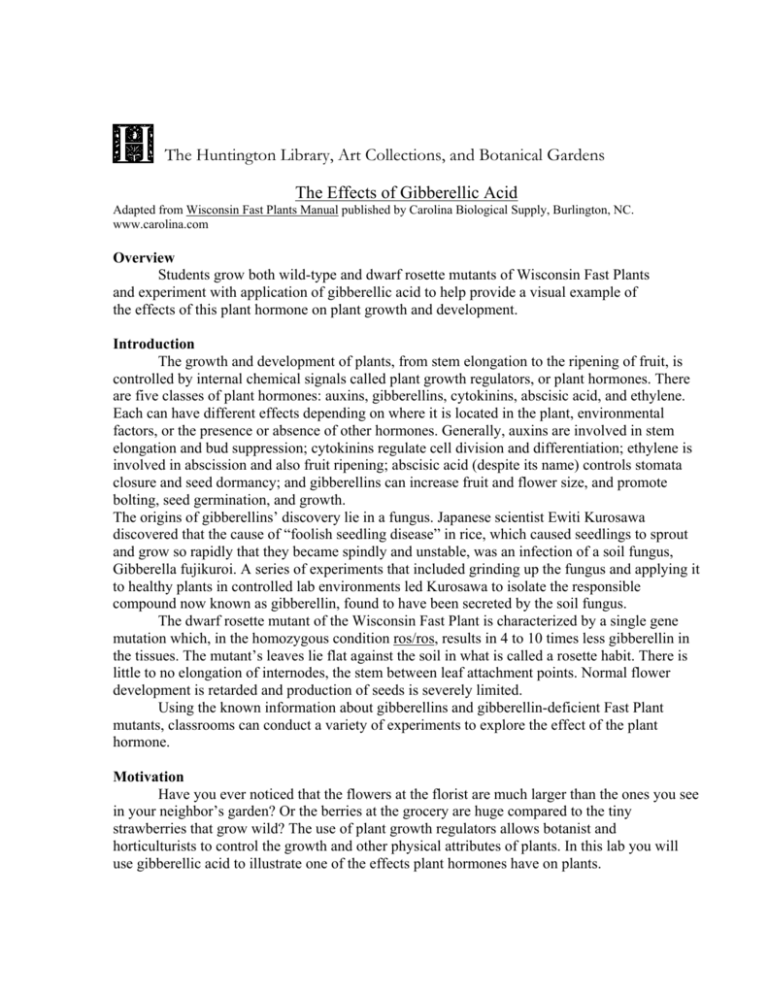
The Huntington Library, Art Collections, and Botanical Gardens The Effects of Gibberellic Acid Adapted from Wisconsin Fast Plants Manual published by Carolina Biological Supply, Burlington, NC. www.carolina.com Overview Students grow both wild-type and dwarf rosette mutants of Wisconsin Fast Plants and experiment with application of gibberellic acid to help provide a visual example of the effects of this plant hormone on plant growth and development. Introduction The growth and development of plants, from stem elongation to the ripening of fruit, is controlled by internal chemical signals called plant growth regulators, or plant hormones. There are five classes of plant hormones: auxins, gibberellins, cytokinins, abscisic acid, and ethylene. Each can have different effects depending on where it is located in the plant, environmental factors, or the presence or absence of other hormones. Generally, auxins are involved in stem elongation and bud suppression; cytokinins regulate cell division and differentiation; ethylene is involved in abscission and also fruit ripening; abscisic acid (despite its name) controls stomata closure and seed dormancy; and gibberellins can increase fruit and flower size, and promote bolting, seed germination, and growth. The origins of gibberellins’ discovery lie in a fungus. Japanese scientist Ewiti Kurosawa discovered that the cause of “foolish seedling disease” in rice, which caused seedlings to sprout and grow so rapidly that they became spindly and unstable, was an infection of a soil fungus, Gibberella fujikuroi. A series of experiments that included grinding up the fungus and applying it to healthy plants in controlled lab environments led Kurosawa to isolate the responsible compound now known as gibberellin, found to have been secreted by the soil fungus. The dwarf rosette mutant of the Wisconsin Fast Plant is characterized by a single gene mutation which, in the homozygous condition ros/ros, results in 4 to 10 times less gibberellin in the tissues. The mutant’s leaves lie flat against the soil in what is called a rosette habit. There is little to no elongation of internodes, the stem between leaf attachment points. Normal flower development is retarded and production of seeds is severely limited. Using the known information about gibberellins and gibberellin-deficient Fast Plant mutants, classrooms can conduct a variety of experiments to explore the effect of the plant hormone. Motivation Have you ever noticed that the flowers at the florist are much larger than the ones you see in your neighbor’s garden? Or the berries at the grocery are huge compared to the tiny strawberries that grow wild? The use of plant growth regulators allows botanist and horticulturists to control the growth and other physical attributes of plants. In this lab you will use gibberellic acid to illustrate one of the effects plant hormones have on plants. Objectives Upon completion of the lab, students should be able to: 1. Outline known information about Wisconsin Fast Plant gibberellin-deficient mutants. 2. Devise an experiment to illustrate the effects of gibberellic acid on said mutants. 3. Demonstrate proper experimental design, execution, and reporting. Materials • Wild-type and dwarf rosette seeds of Wisconsin Fast Plants • Necessary planting materials (following Wisconsin Fast Plant protocol) • Disposable pipettes • Rulers • Gibberellic acid (GA) Associated California State Biology Standard 9i. Students know how hormones (including digestive, reproductive, osmoregulatory) provide internal feedback mechanisms for homeostasis at the cellular level and in whole organisms. Procedure 1. Introduce and provide a description of the growing instructions for Wisconsin Fast Plants (see www.fastplants.org). 2. Use journal article(s) about fast plants and gibberellic acid to generate a class list about what is known about the effects of GA on Fast Plants and what is still unknown, needs more testing, and/or what the class wants to find out. 3. As a class, you will decide on the parameters of the experiment. You should devise an experiment or experiments that will illustrate the effects, if any, of introducing gibberellic acid (GA) to a gibberellin-deficient mutant. You will need to follow the growing instructions for Fast Plants, and keep in mind the following: • Dwarf rosette mutants have poor flower and fruit development, and do not undergo elongation of internodes. • Your experiment must provide treatment controls. • You must start enough seeds for controls and all experiments. • You will compile class results. Think of recording and presenting results in tables and graphs. • You must decide how to quantify the effect of GA. • GA can be applied topically or to the soil. You should decide on a protocol for application, or you may wish to test this as your experiment. Evaluation The following questions are listed under the Analysis section of the student handout and may be used as part of a report, class discussion, or assessment. 1. What were the physical differences between the mutant fast plants and the wild type fast plants? 2. Where did you apply the gibberellic acid on the mutant plants and what was the result? Why do you think this occurred? 3. What treatments and controls did you use during your experiment? How were the controls different than the treatment groups? 4. Is there a dosage effect from gibberellic acid? Can too much or too little affect growth? Explain. 5. How did you quantify your results? Using your results, what applications can you think of for using this hormone? Extension Activity 1. Gibberellin is produced in the apices of roots and shoots. Devise an experiment testing the effectiveness of applying a liquid extract of root and shoot tips to GA-deficient rosettes. Do root and shoot extracts have an effect? Is the effect different between roots and shoots? How do these results compare to your results with the commercial GA solution? Test Preparation 1. Which of the following is not considered a plant growth hormone? (A) Cytokinins (B) Gibberellic acid (C) Ethylene (D) Abscisic acid (E) Ascorbic acid Student Sheet: The Effects of Gibberellic Acid Name:________________________ Procedure 1. You will review the life cycle and growth of Wisconsin Fast Plants with your teacher. 2. Using the reading material provided by your teacher, list what is known about the effects of gibberellic acid (GA) on Fast Plants and what is still unknown, needs more testing, and/or what you want to find out. 3. As a class, you will decide on the parameters of an experiment you will conduct to explore the effects of GA on Fast Plants. You should devise an experiment or experiments that will illustrate the effects, if any, of introducing gibberellic acid (GA) to a gibberellin-deficient mutant. You will need to follow the growing instructions for Fast Plants, and keep in mind the following: • Dwarf rosette mutants have poor flower and fruit development, and do not undergo elongation of internodes. • Your experiment must provide treatment controls. • You must start enough seeds for controls and all experiments. • You will compile class results—think of recording and presenting results in tables and graphs. • You must decide how to quantify the effect of GA. • GA can be applied topically or to the soil. You should decide on a protocol for application, or you may wish to test this as your experiment. Analysis On a separate sheet of paper, please complete the following: 1. What were the physical differences between the mutant fast plants and the wild type fast plants? 2. Where did you apply the gibberellic acid on the mutant plants and what was the result? Why do you think this occurred? 3. What treatments and controls did you use during your experiment? How were the controls different than the treatment groups? 4. Is there a dosage effect from gibberellic acid? Can too much or too little affect growth? Explain. 5. How did you quantify your results? Using your results, what applications can you think of for using this hormone?
